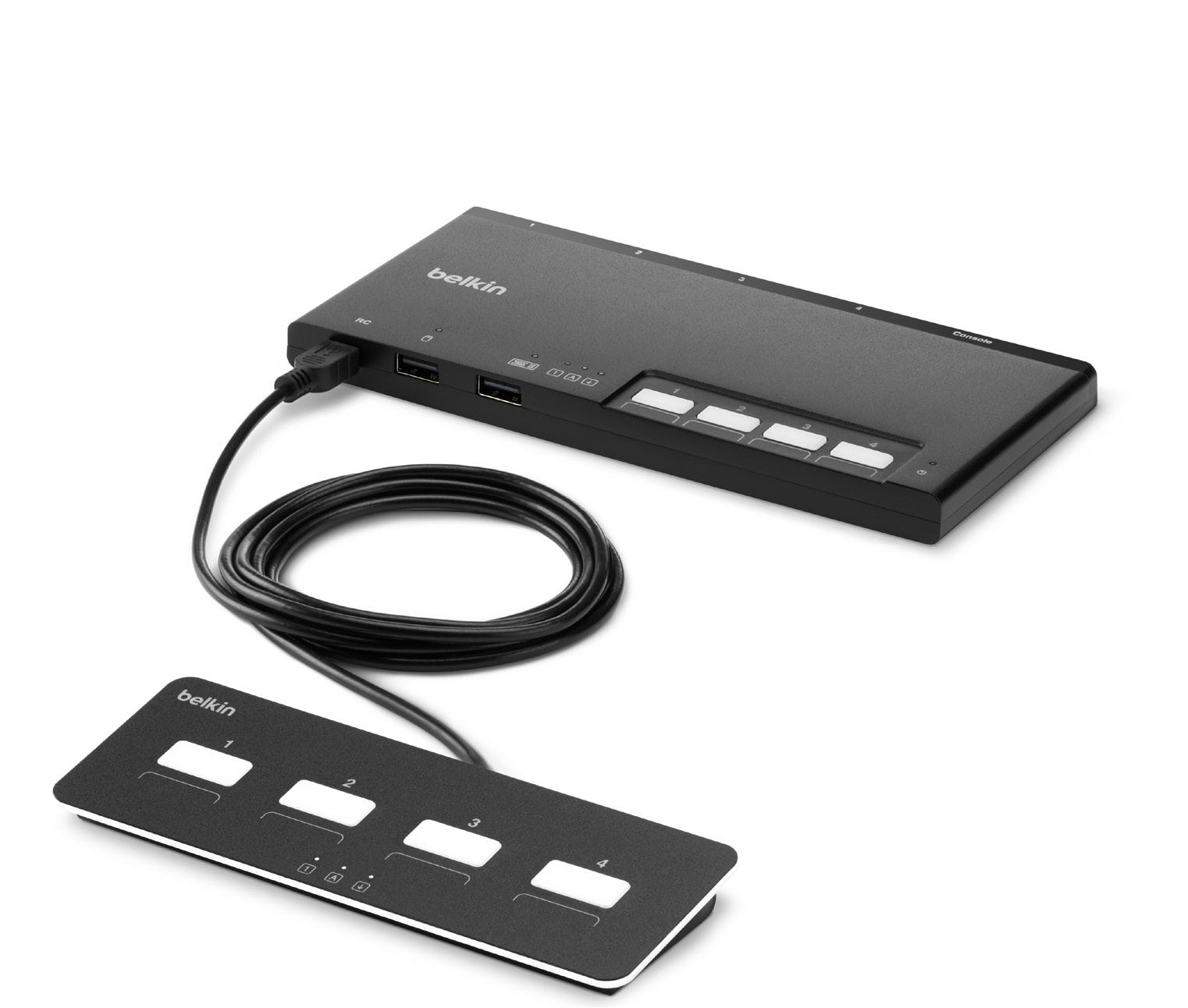

Custom


Connections The Secure KM Switch
Viewing and Interacting with Multiple Systems Simultaneously
The Secure KM Switch (models F1DN002MOD-KM-4, F1DN004MOD-KM-4 and F1DN108MOD-BA-4*) is engineered for high-security environments where operators require simultaneous interaction with multiple computing systems across different security enclaves. Unlike the traditional Secure KVM, the Secure KM only switches the USB keyboard and mouse between connected inputs, relying on individual computers to drive their video displays. The Secure KM is the ideal technology for IT environments that demand rigorous cybersecurity provisions – including government, military and healthcare applications.
The Belkin Secure KM Switch can simultaneously support two, four or eight computers using a single keyboard and mouse. The F1DN004MOD-KM-4, supporting four computers, is used as the reference below for demonstration purposes.
Hardware Requirements:
- Up to four F1DN1MOD-USB06
(Belkin Modular USB Cable for Secure KM 6 ft.)
- 1x Power Port
Software Requirements:
- Software must be installed only on any computer or system if a connected system has multiple monitors. In cases where connected computers have multiple monitors (the Secure KM can work with computers running Windows® with up to four monitors per computer), the Belkin Multi-Monitor Mouse Driver is necessary. The driver can be found at www.belkin.com/us/support-article?articleNum=286117.
- Please note custom configuration files created in one version of Windows may not be able to be uploaded to a Secure KM using a different version of Windows. It is recommended that the exact version of the Windows operating system be used to create and load a custom monitor configuration file to Belkin Secure KM Switches.



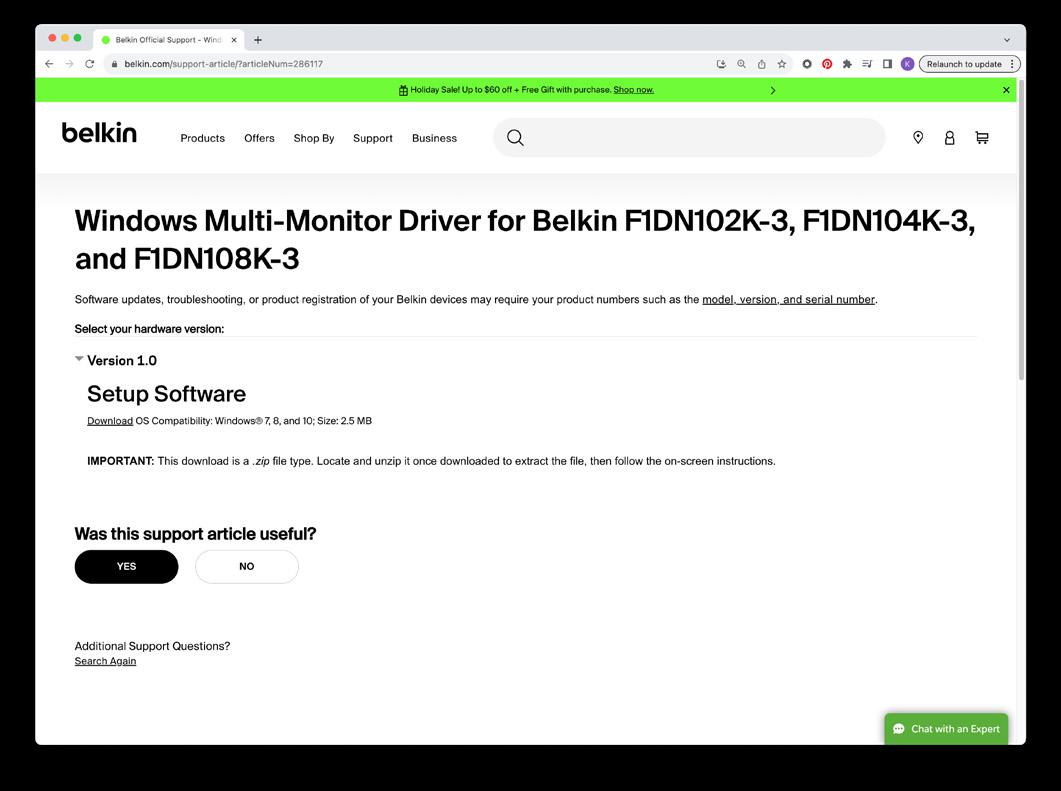
Secure KM Switch controls and modes
Keyboard and Mouse
As with Belkin’s Secure KVMs, each Secure KM’s keyboard and mouse USB port is isolated using the same optical data diode technology to eliminate signal leakage. Further, no user data is buffered in the Secure KM to prevent security vulnerabilities. These ports use advanced emulation for USB HID commands and physically block any reverse data flow, ensuring that malicious code has no way of migrating from an infected peripheral to a secure system and confidential data has no way of being copied onto portable USB media devices.
Mouse
The Secure KM mouse function can be configured to work in either Absolute or Relative Mode. In either case, commands are sent to one computer at a time via the optical data diode isolation described above, and the cursors being emulated on the other computers are hidden from view.
Absolute Mode:
In Absolute Mode, the Secure KM maps all monitors onto the same grid, maintaining the coordinates that reflect the edge of one physical monitor to another. As the cursor is moved from the coordinate at the edge of one physical monitor and onto the coordinate indicating the edge of its neighbor monitor, the Secure KM passes data from the physical mouse to the USB emulation logic for the second computer. Additionally, it paints the cursor onto its corresponding monitor (while simultaneously hiding the cursor on the former monitor). It also invokes the Seamless Cursor Switching (SCS) mechanism to seamlessly switch the mouse and keyboard controls to the corresponding input source.
The Secure KM’s mouse emulators offer zero delay in switching between computers, allowing instant response. In keeping with information assurance requirements, the Secure KM’s button panel illuminates the new channel’s button LED to provide constant visual feedback to operators indicating with which enclave they are working. Under no circumstances will cursor commands be sent to more than one system simultaneously.
Relative Mode:
In Relative Mode, the mouse’s movement is confined to the borders of each computer’s display. The user must then select which console to interact with by pressing the appropriate channel selection button on the Secure KM Switch, similar to a traditional Secure KVM.
Keyboard
The keyboard connected to the Secure KM interacts with each computer individually and only with one computer at a time. A user can switch the keyboard’s interaction between computers by pressing the console buttons on the Secure KM or by using the mouse’s movement in Absolute Mode to invoke cursor-based switching.
Since mouse and keyboard data flow in a unidirectional data path, any keyboard indicators that require acknowledgment from the computer will not be shown, including LEDs for Caps Lock, Num Lock, or Scroll Lock. For example, when a user presses the Caps Lock key, the command will reach the computer and activate all keys as caps. However, the computer will not be able to acknowledge the change back to the keyboard to enable the key’s LED indicator.
Absolute mouse-screen areaSecure KM Switch controls and modes
Working with the SKM Configuration Tool to create custom monitor layouts
Display
The Secure KM provides for various pre-configured monitor configurations that should meet most user requirements. The size, relative positioning and coordinates of these display configurations are pre-programmed in the Secure KM and can be selected through administration options.
Should one of these presets be inadequate for the application, the Belkin SKMs also support a custom configuration option using the Belkin SKM Configuration utility that can be downloaded from https://www.belkin.com/au/support-article?articleNum=208563.
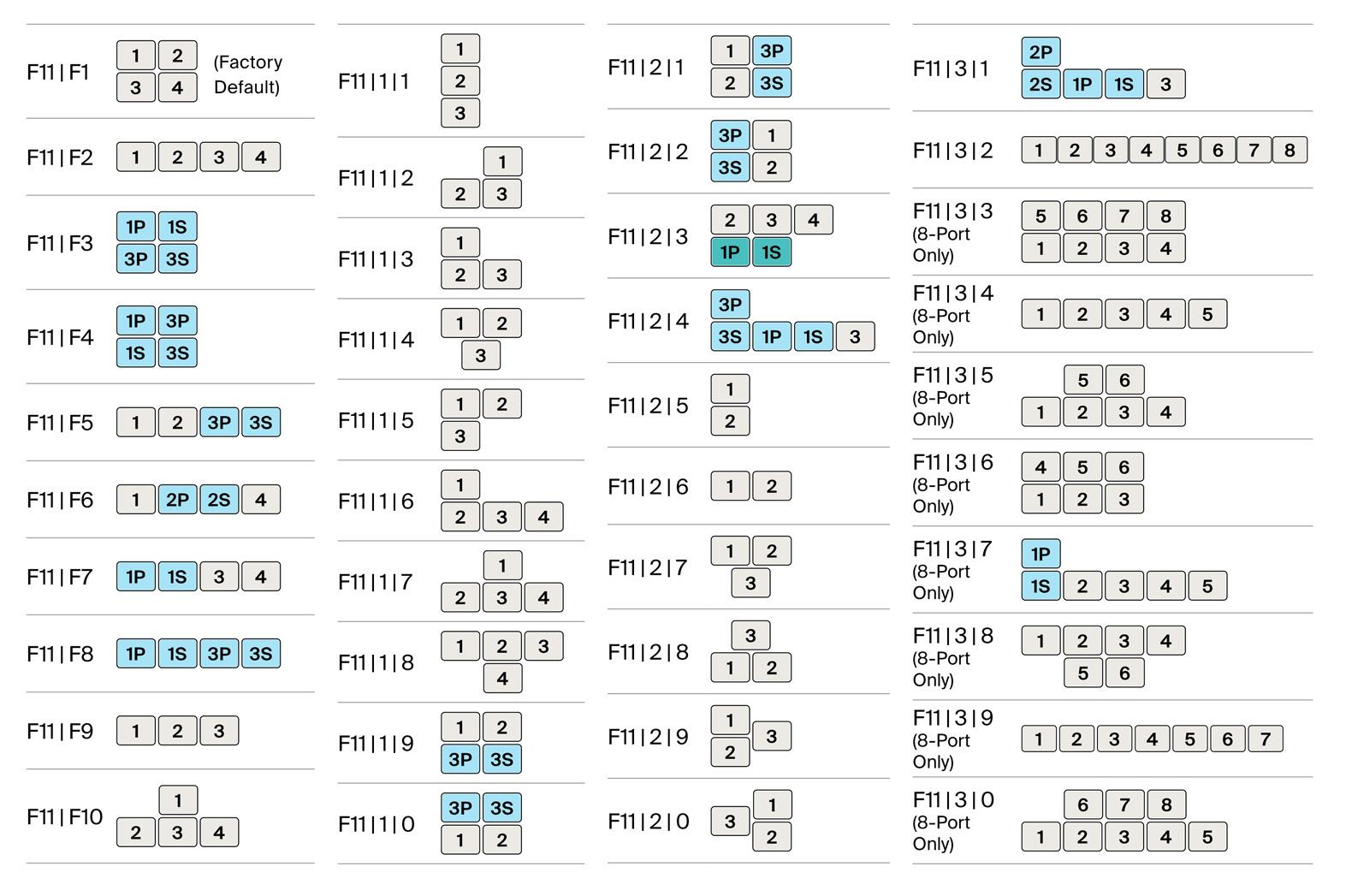
Requirements:
1. Belkin Secure KM
2. Windows-compatible PC (Windows 7 or higher recommended)
→ Please note that the exact version of the Windows operating system should be used to create and load a custom configuration file.
3. USB Type-A to USB Type-A cable
Step 1: Download and install Belkin_KM_Tools_Setup-2.6.exe on a Windows machine. The following items will be installed:
1. KMCreator (KM Configuration Utility Version 2.06)
2. KMLoader (KMConfigLoader Version 1.0.0.6)
3. KM Device driver (Belkin Reg – CDC Driver/Belkin Registration Device)
Install the Belkin_KM_Tools_Setup-2.6.exe:
a) Review EULA and select “Next.”
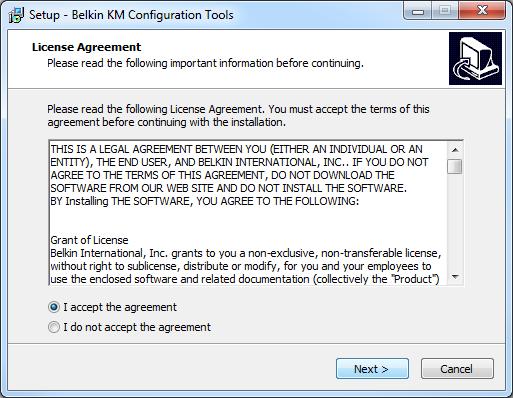
b) Choose the location to install files and select “Next.”

c) Choose a folder for program icons and select “Next” to begin the installation.

d) Select “Install” to begin and follow the installation wizard to complete the process.

e) Once complete, select “Finish.”
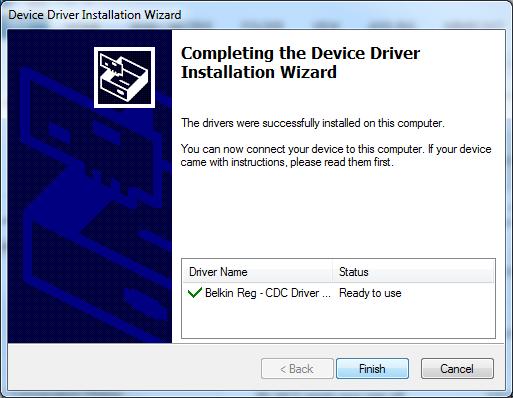
Once the installation wizard is complete, shortcuts for KM Creator and KMLoader will be available in your chosen file location.
Step 2: Define monitor configuration with the Secure KM Configuration Utility
The KMCreator defines the monitor layout and generates a Secure KM configuration file (.kmc file) that will be uploaded to the Secure KM using the KMLoader utility.
Using the KMCreator utility, administrators can define the layout and relevant traits of monitors connected to each computer with different or identical sizes and screen resolutions. The monitors can be deployed in any physical layout. This software also removes unneeded bridges between monitors that can be used to prevent channel switching via the SCS capability.
Before You Begin
A Secure KM configuration file is based on the number of computers connected to the Secure KM and the number, size and resolution of the monitors with which each computer will be associated. 1. Create a new project
Each Secure KM configuration file is called a “Secure KM Configuration Project.” You must create a new project for every setup. At any point during the configuration process, you can click “Back” to return to the previous stage.
NOTES:
1. The KMCreator and KMLoader software does not need to be loaded on each computer.
2. The software should be installed on an external computer to upload the configuration to the Secure KM. Suppose one computer is used to create the configuration file and another to load it. In that case, it is recommended that the exact version of the Windows operating system be running on both computers. The KMCreator and KMLoader software are not needed after loading the desired configuration onto the Secure KM.
• Open KMCreator.
• Select “New Project.”

2. Enter project details
Please enter the requested information in the following manner:
• Project name – The name can be a combination of English characters or numbers. Using a name that will reflect the configuration, such as “Dealer 3 5 monitors” or “Generic Workstation 7” is advised. The project name can be read from the Secure KM after loading.
• Product model – The Secure KM Switch’s product model can be found on its label. The Belkin Secure KMs come in 2- and 4-input models.
• Mouse speed – This is the default mouse speed for all systems. Changing the mouse speed on each computer will not affect the Secure KM mouse speed.
• Mouse acceleration – Same as above.
• Number of computers – This configuration’s total number of computers connected to the Secure KM. This assumes that the end user will always begin on port #1 on the SKM.
• Click “Next Step.”
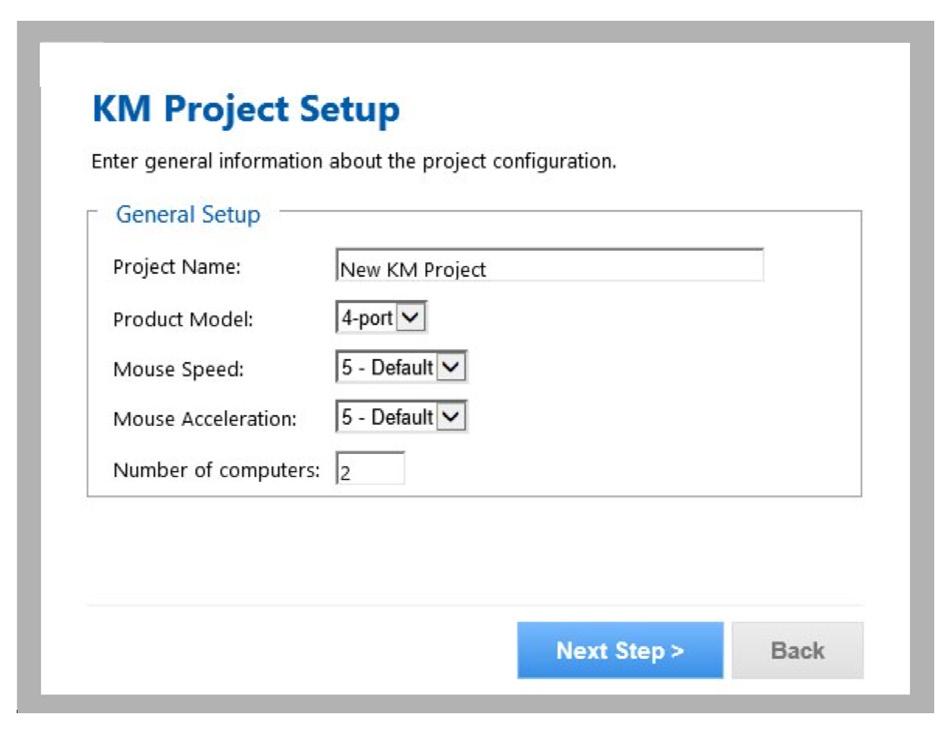
3. Enter description
Add a description of the project. The description will appear in the configuration file (.kmc) and help differentiate one configuration from another when working with multiple potential configurations.
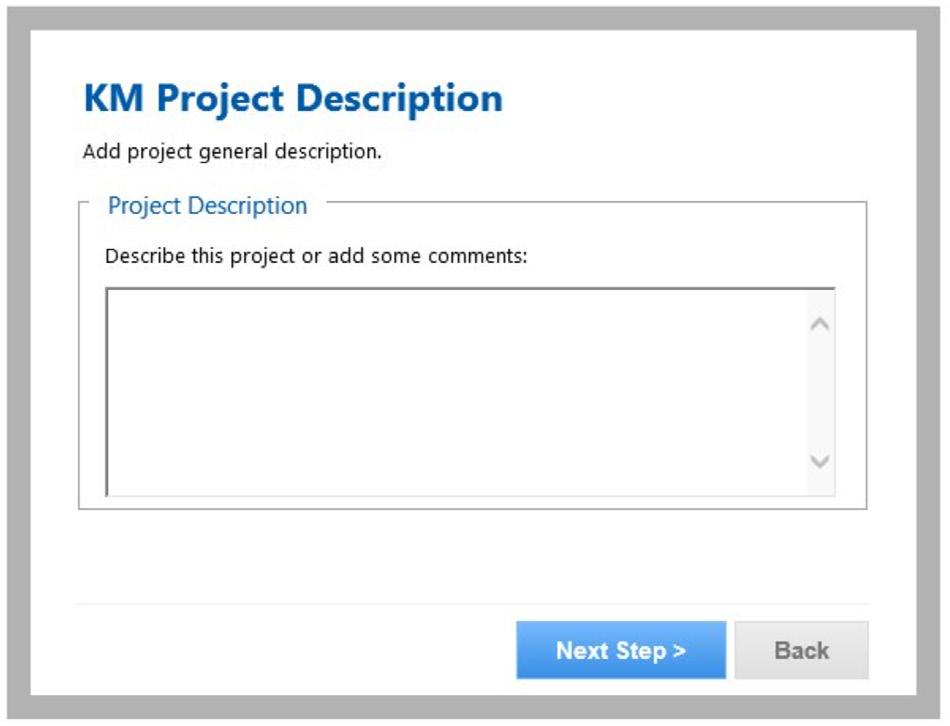
4. Monitor configuration
For each computer, define the number of monitors connected to the computer by selecting it from the drop-down menu: “Number of Displays.” The maximum number of possible displays is limited to four per computer. Once the number of monitors is selected, you can enter the size and native resolution for every monitor.
NOTES:
If a particular monitor is set to portrait orientation, the native resolution should be entered accordingly. For example, for a monitor with a native screen resolution of 1680x1050, which is used in portrait orientation, enter the resolution as 1050x1680.
Display Diagonal Inches are not relevant. Any size display can be entered in the (inch) entry as long as it matches the ratio of the aspect resolution you provide.
For example, the configuration may have all 43-inch displays with 3840x2160 resolutions. However, any size display required by the configuration can be entered in the Display Diag (inch) box.
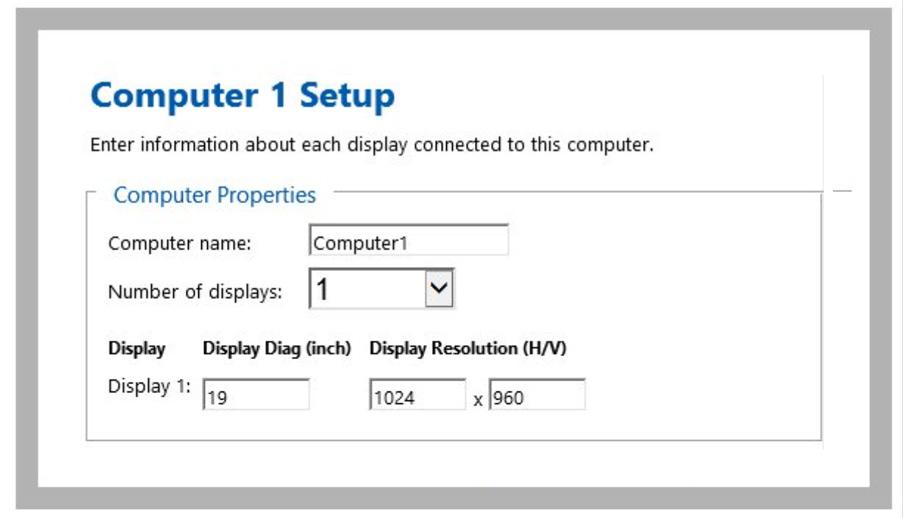
Working with multiple monitors per computer
When using more than one display per computer, Microsoft Windows display options must be synchronized with the Secure KM for proper operation.
Microsoft Windows maps monitors into a virtual desktop, allowing users to move the mouse cursor from one monitor to another. The Secure KM must understand how these monitors are mapped in a Windows desktop environment and which monitor defines the edge between channels to invoke SCS channel switching. This procedure must be done for each PC with multiple monitors.
Adding Additional Displays
• Adding a display to the LEFT of the primary display will have a Negative value of the display HORIZONTAL resolution with the same vertical resolution of Display 1 (Primary) as shown below:

Understanding the Orientation of the Custom Displays
All Primary Displays will have the coordinates (0,0). The coordinate system of the screen follows the Cartesian coordinate system in which the origin (0,0) is at the top left of the screen. Positive x increases toward the right and positive y increases toward the bottom.
• Adding a display to the RIGHT of the primary display will have a Positive value of the display HORIZONTAL resolution with the same vertical resolution of Display 1 (Primary) as shown below:

• Adding a display UNDERNEATH the primary display will have a Positive value of the display VERTICAL resolution with the same vertical resolution of Display 1 (Primary) as shown below:
• Secondary display will have the same Horizontal resolution of Display 1 (Primary):

• Adding a display ABOVE the primary display will have a Negative value of the display VERTICAL resolution with the same vertical resolution of Display 1 (Primary) as shown below:
• Secondary display will have the same Horizontal resolution of Display 1 (Primary):

• MS H/V Coordinates entered will be the position based on the Display 1 (Primary) and will follow the same methods. For example, the below coordinates will render 3 displays arranged in a linear flow of 1-->2-->3

1. To begin, open the display settings dialog on the Windows PC.
• Right-click on the desktop and select “Display Settings” or navigate to Control Panel, Display Settings.
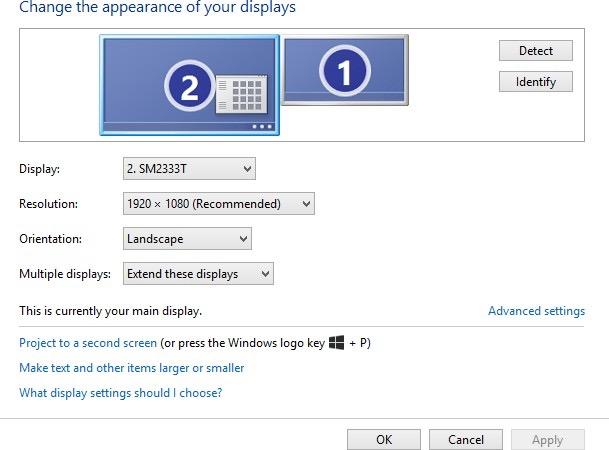
The following instructions are based on Windows 7 but can also be used with Windows 8 and Windows 10.
2. You will be asked to provide information regarding your primary display in the Secure KM configuration dialog. The primary display is the “main display” in the Windows “Screen Resolution” dialog. You can determine which monitor is the main display by selecting it in the array of displays as shown below.

Main display identified in Windows
3. Select the appropriate number of monitors in the KMCreator dialog for Computer 1. Selecting more than one monitor exposes the additional details.
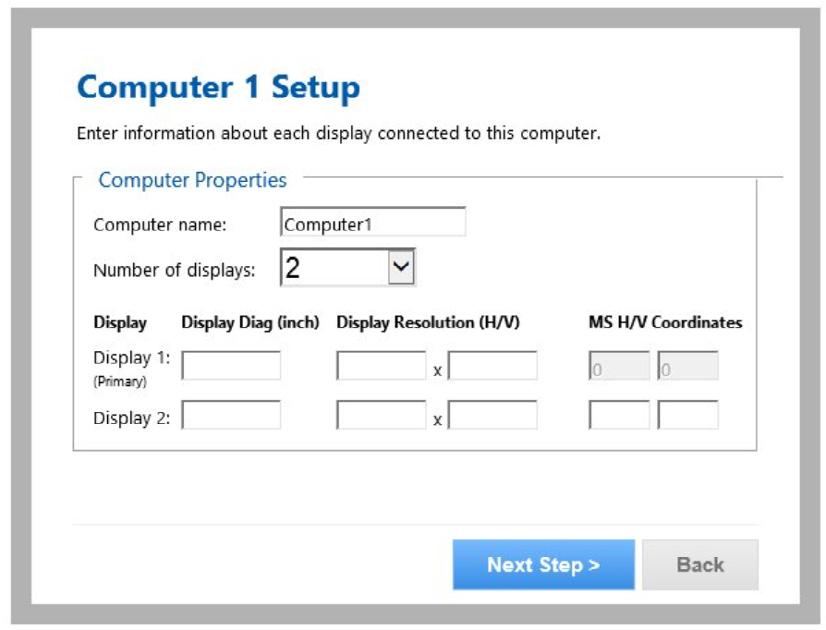
4. Enter the details for your primary (main) display as requested in the dialog.
5. Enter the details for the secondary display.
a) Select the secondary monitor in the Windows Display Settings dialog box to find the vertical and horizontal coordinates and move it slightly. The Vertical and Horizontal values of the monitor will appear in Windows 7 and Windows 8 computers per the below screen capture:

b) Windows 10 hides these coordinates, requiring the administrator to calculate the relative position as follows: i) The Primary monitor has XY coordinates 0,0 mapped to its upper left-hand corner.
ii) If the monitor is a 1920x1080 monitor, the coordinates of the second monitor immediately to its right will start at 1920,0 assuming both monitors are in landscape mode. Enter 1920,0 for the secondary monitor in the KMCreator dialog box.
6. Place the displays and create the channel associations in the KMCreator interface.
In this step, we will map the monitors at an operator’s desk, defining their relative position to each other and the associated channels for SCS switching.
• The computer and monitor numbers identify each display entered previously.
• Monitors can be connected or have some distance, all based on the actual geometry required.
• Once the monitors are aligned, a yellow “bridge” will appear, indicating where the Secure KM will switch mouse/ keyboard/audio control from one channel to the other.
• Clicking on one of the bridge areas will toggle it off, which prevents the SCS channel switch and requires the operator to press the appropriate channel button on the front of the Secure KM Switch.
• To re-enable the bridge between monitors, drag one monitor toward the desired neighboring monitor, having them touch each other at the appropriate edge. Pull apart the monitors, and the bridge will appear between the monitors again.
Examples:
Example 1: The following setup creates a corridor from the top right of Monitor 2, Computer 2 to the bottom left of Monitor 1, Computer 1.
Dragging the mouse through the portion of the monitors connected by the yellow bridge will switch channels between channels 1 and 2.
Attempting to drag the mouse through one of the areas depicted by the blue highlights in the figure below will block SCS from switching channels.
Example 2: Both configurations below create identical setups in which the mouse cursor moves from the right of Computer 2 to the left of Computer 1.
Example 3: The setup shown in Fig. 1 below will not invoke an SCS-based channel switch, as there is no bridge between the two monitors.
However, touching the monitors per Fig. 2 creates a bridge and invokes SCS-based channel switching.
Example 4: The two setups below are identical, except that on the setup on the right, the user chose to prevent the mouse cursor from moving from Computer 2, Display 2 to Computer 1, Display 1 by clicking on the yellow bridge to toggle it off.
Note the following considerations when working with systems that have more than one monitor per computer:
• The monitor orientation in Windows must match the monitor orientation in the KMCreator utility
• All displays connected to the same PC must be positioned as touching each other in the KMCreator interface. Do not depict the distance between two displays connected to the same computer.
7. Complete setup.
Once the monitor configuration is defined, press “Complete Setup” to generate the .kmc file.
Step 3: Load the configuration file to the Secure KM
KMLoader allows you to load the configured .kmc file (created per the procedure in Step 2) into the Secure KM Switch. If using a different computer to create the .kmc file and a second one to upload the file, it is recommended that both computers run on the same version of the Windows operating system.
Setting Up the Secure KM Switch for Loading the Configuration (.kmc) File
The Secure KM Switch is configured through a USB-A to USB-A cable connected from a PC containing the KM Loader to one of the console USB ports on the Secure KM. The USB-A to USB-A cable is not included with the KM and must be purchased separately.
1 To put the Secure KM Switch into programming mode, type Left Ctrl, Right Ctrl and then L on the connected keyboard. The Secure KM Switch will click several times audibly, and all LEDs will flash simultaneously to indicate that the unit is in programming mode.
2. Check that the Belkin Registration Device has been installed properly:
a) Open Device Manager on Windows PC.
b) Look for Ports (COM & LPT) and then Belkin Registration Device or USB Serial Device. If Device Manager shows either, the driver was installed correctly, and you can proceed to the “Loading the Utility” step. If not, follow the below process:


c) If the Belkin Registration Device is not present, look for Universal CDC Loader under Other Device Manager:

d) Right-click on Universal CDC Loader and choose “Update Driver Software.”

e) Select “Browse my computer for driver software” from the following dialog:

f) Select “Let me pick from a list of device drivers on my computer” on the following dialog:
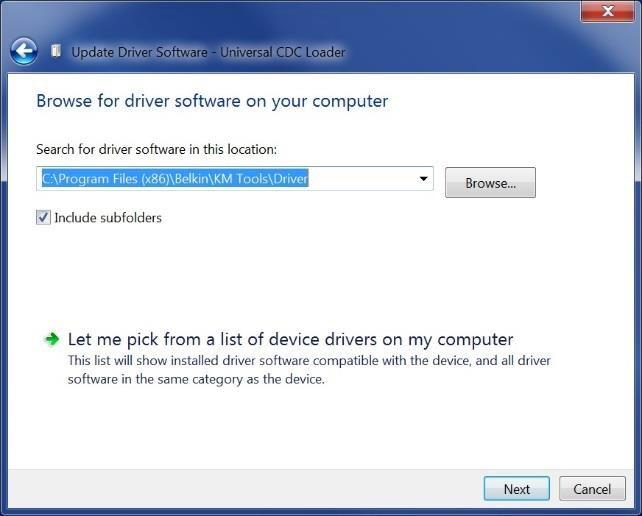
g) Select “Ports (Com & LPT)” from the following dialog and click “Next.”

h) Select “Have Disk” on the following dialog box.

i) Navigate to the folder that the Belkin Tools were installed in (C:\Program Files (x86)\BelkinKM Tools\Driver) and select “OK.”
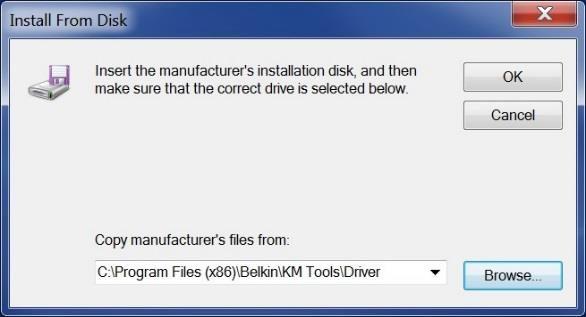
j) Select the BelkinRD file and select “Open.”
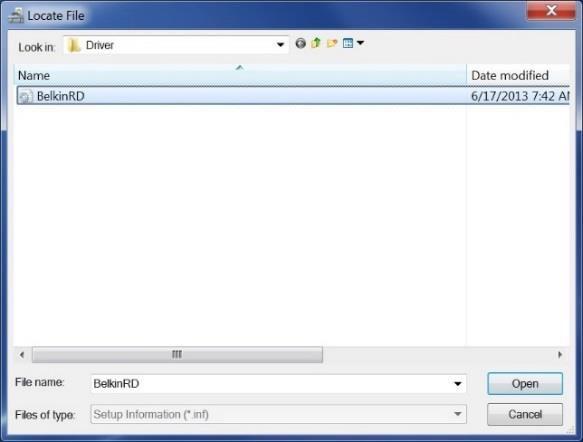
k) On the subsequent dialog, select the Belkin Registration Device and select “Next”; if a dialog asks you to confirm the installation, select “Yes,” and if another dialog requests confirmation, select “Install.”
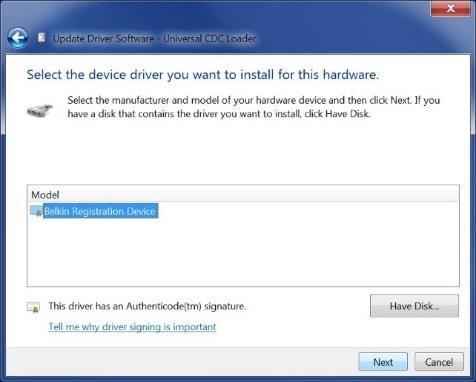


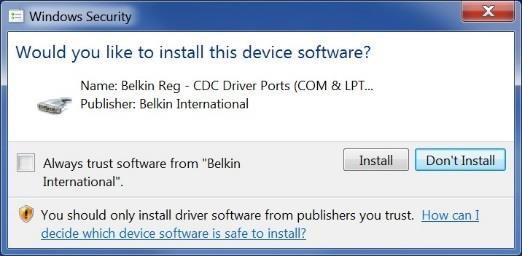
l) Once complete, check Device Manager for Belkin Registration Device again to ensure the driver was successfully installed. Device Manager should look similar to the following image:

Loading Utility
Once the Secure KM Switch is in programming mode and connected to the PC:
1. Open the Secure KM Configuration Loader utility.
2. Ensure the KM Loader window shows “Device Connected” in the lower left corner.
Loading a Configuration file
1. Select “Browse” to load Configuration File in the “Select Configuration File” field.
2. Locate your .kmc configuration file.
3. Select “Process.” If successful, the KM Configuration Loader Tool Window will show “Configuration file has been successfully loaded to the device.”
4. Power cycle the PC device.
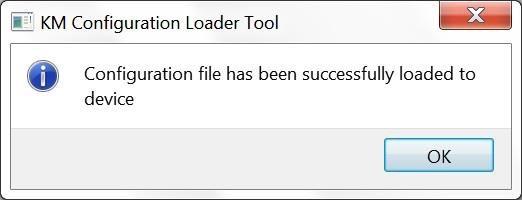
5. Power cycle the Secure KM, then press Left CTRL, Left CTRL, F11 and F12 to load the new configuration and begin using it.
3. Select COM port “COM # (Belkin Registration Device/USB Serial Device)” (COM port # will differ from system to system).
4. Select port configuration “2,” “4” or “8” for 2-, 4- and 8-port SKMs, respectively.


The 2- and 4-port Modular Secure KMs enable users to securely switch between two or four computer sources while simultaneously viewing all computers on different displays. They’re designed for use in defense and intelligence installations requiring consolidated control between computers at different security enclaves, and provide the stringent safeguards required by today’s IA (Information Assurance) computing requirements.
Additionally, our 8-port Modular SKVM can be converted to an SKM. Please see our How-To Guide located at www.belkin.com/cybersecurity/resources for how to use your 8-Port SKVM as an 8-Port SKM.








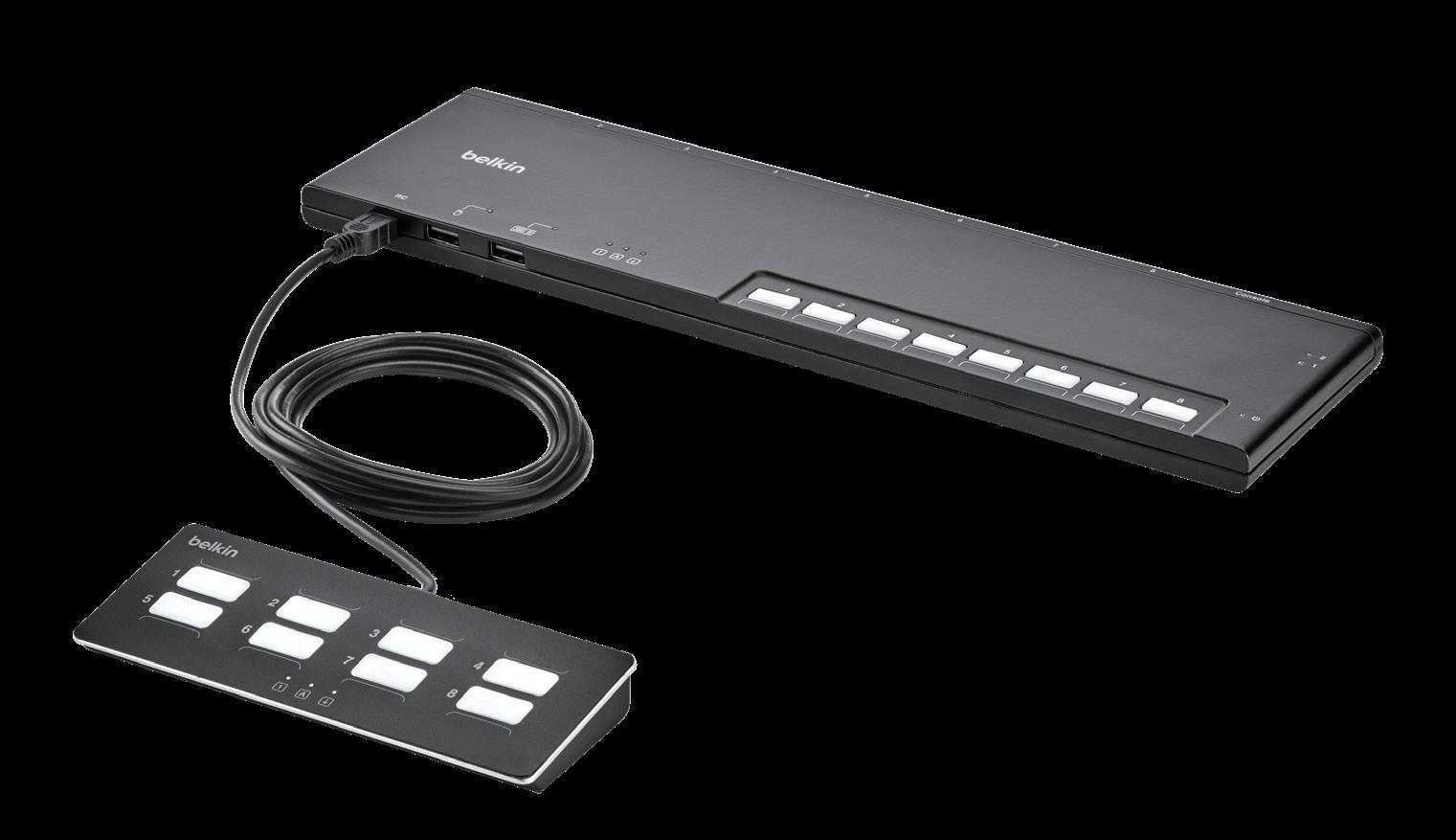


 2-port Modular Secure KM with packaged cabling for USB to 2 Host PCs.
F1DN002MOD-KM-4
4-port Modular Secure KM with packaged cabling for USB to 4 Host PCs.
F1DN004MOD-KM-4
8-port Modular Secure KVM
F1DN108MOD-BA-4
2-port Modular Secure KM with packaged cabling for USB to 2 Host PCs.
F1DN002MOD-KM-4
4-port Modular Secure KM with packaged cabling for USB to 4 Host PCs.
F1DN004MOD-KM-4
8-port Modular Secure KVM
F1DN108MOD-BA-4


